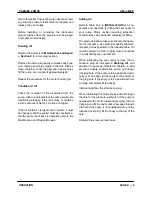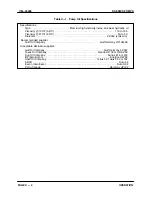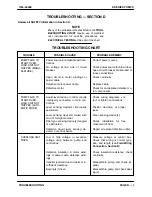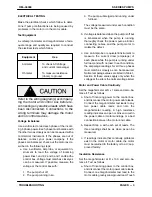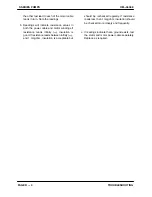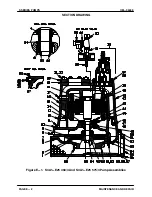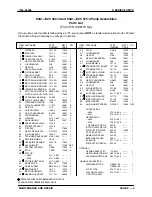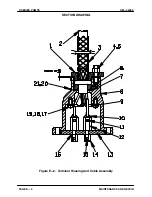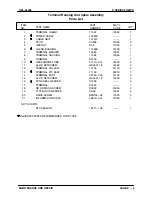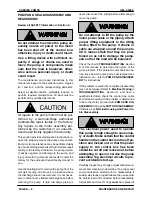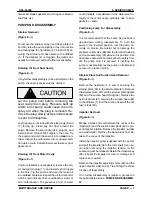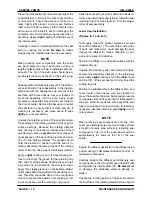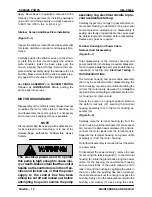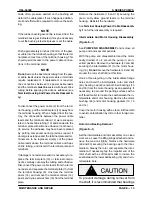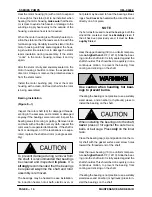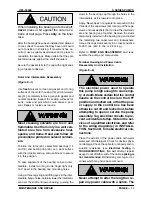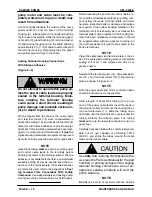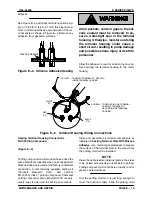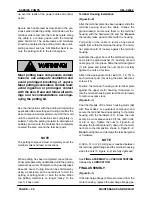
OM-06098
S SERIES PUMPS
PAGE E - 7
MAINTENANCE AND REPAIR
disturbed. Repair gaskets and O‐rings are listed in
the Parts List.
PUMP END DISASSEMBLY
Strainer Removal
(Figure E-1)
To remove the strainer screen and base plate (55
and 56), raise the pump slightly, or lay it on its side
and disengage the hardware (57, 58 and 59) se
curing the strainer and base plate to the diffuser
(1). If the impeller (2) is clogged, the debris can
usually be removed without further disassembly.
Draining Oil From Seal Cavity
(
Figure E-1)
If any further disassembly is to be performed on the
pump, the seal oil cavity must be drained.
Let the pump cool before removing the
seal cavity drain plug. Pressure built up
within a hot pump could cause the oil to
spray out when the plug is removed. Re
move the plug slowly and permit pressure
to vent to atmosphere.
Lay the pump on its side with the pipe plugs (8 and
11) facing up. Clean any dirt from around the
plugs. Remove the seal cavity drain plug (8), and
install a short 3/8‐inch NPT nipple in the hole. Tip
the pump and drain the seal oil into a
clean
con
tainer. Inspect the oil for water, dirt, or cloudy condi
tion which could indicate lower seal failure or poor
gasket seal.
Draining Oil From Motor Cavity
(
Figure E-1)
If motor problems are suspected, remove the mo
tor cavity drain plug (11), and install a short nipple
in the hole. Tip the pump and drain the motor oil
into a
clean
container. Inspect the oil for dark color
which could indicate motor overheating, water or
dirt contamination. The presence of dirt or water
could indicate a breakdown in the waterproof in
tegrity of the motor cavity, probably due to poor
gaskets or seals.
Positioning Pump For Disassembly
(Figure E-1)
It is recommended that the pump be positioned
upside‐down during disassembly. To hold the
pump in the inverted position, rest the pump se
curely on blocks. Be careful not to damage the
pressure relief valve (28) and the terminal housing
and cable assembly (33) while in this position. Use
adequate equipment and personnel to safely han
dle the pump until it is secured. If inverting the
pump is not practical, lay the pump on its side and
secure it to prevent rolling.
Strainer Plate And Suction Head Removal
(Figure E-1)
Remove the hardware (5, 6 and 7) securing the
strainer plate (53) to the intermediate (51). Remove
the strainer plate. Discard the strainer plate gasket
(52) and the suction head O‐ring (54). Remove the
nylon locknuts (61) securing the suction head (62)
to the diffuser (1). Pull the suction head off the dif
fuser studs (60).
Impeller Removal
(Figure E-1)
Wedge a block of wood between the vanes of the
impeller (2) and the suction head studs (60) to pre
vent impeller rotation. Remove the impeller nut (64)
and washer (63). Remove the wood block from be
tween the vanes of the impeller.
Install the impeller puller (supplied with the pump)
and pull the impeller from the rotor shaft. Use cau
tion when removing the impeller; tension on the
seal spring will be released. Retain the impeller key
(65). Inspect the impeller for wear or damage and
replace as required.
Remove the impeller adjusting shims (36) and the
upper impeller washer (35). Tie and tag the shims
for ease of reassembly.
If no further disassembly is required, proceed to
the appropriate areas in
PUMP END REASSEMB
LY
.



